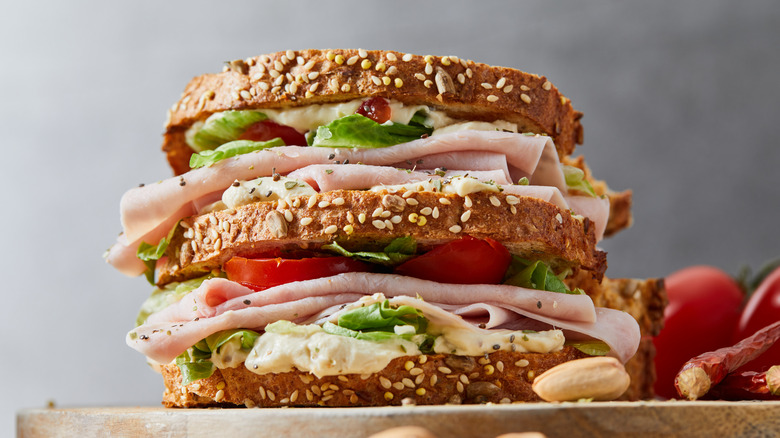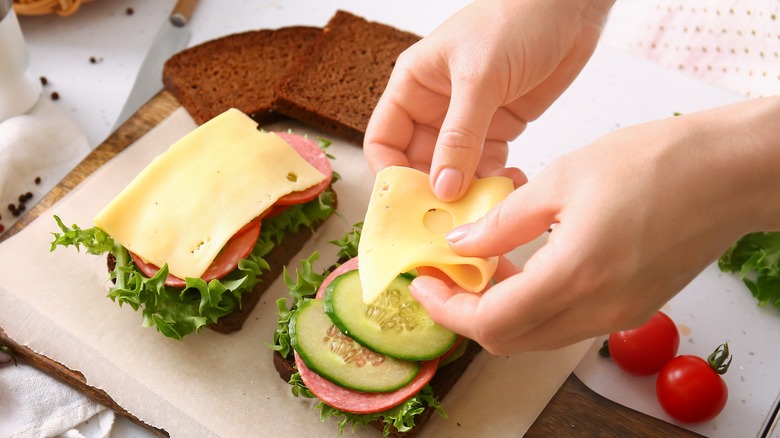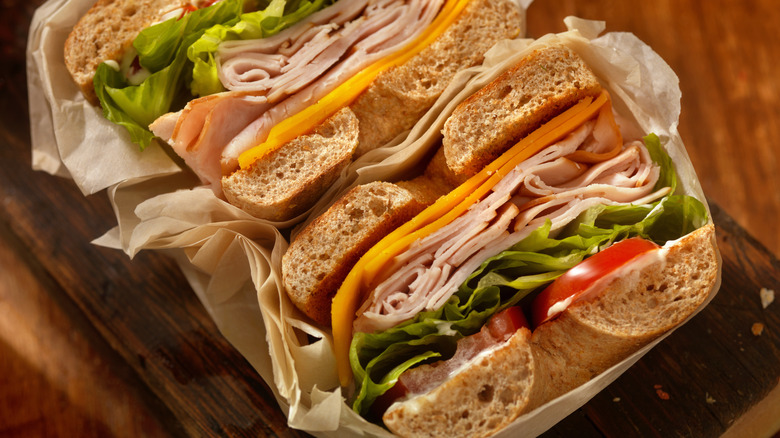The Mistakes That Make Sandwiches Soggy & How To Fix Them
Whether it's a BLT or an Italian sub, the promise of a delicious sandwich halfway through a busy day is one of the best motivators to push through it. That's why taking the first bite of your carefully-crafted 'wich, only to be met with a soggy sponge of sauce and fillings, is so incredibly disappointing. Fortunately, there are a myriad of ways to prevent a sad, soggy sammy. Some of these techniques require more planning than others, but if you want your packed lunch to stay at its best for as long as possible, they're all worth a try.
Perhaps the most straightforward way to preserve the integrity of your sandwich ingredients is to pack them individually, then assemble your lunch right before you chow down. The most troublesome ingredients are ones that contain a lot of moisture, like watery tomato slices, pickles, tuna salad, and runny condiments. It's a huge mistake to place them right on the bread, as the moisture will seep out and soak in. Simply pack items like these in a separate bag or container.
Meanwhile, you can stick dry ingredients like deli meat and cheese between the bread slices in advance, as they're not likely to sog things up. Assembling your sandwich on-site will guarantee the freshest flavor and texture, but not everyone has the time or space — luckily, a handful of simpler methods also work well.
Protect the bread from moisture
Moisture is the enemy in the war for satisfying sandwiches, so set yourself up for success by avoiding warm, ooey-gooey ingredients. While Philly cheesesteaks and steak and cheese sandwiches (yes, there is a difference) are scrumptious right after they're made, that appeal fades after they've sat in the office fridge. Cooked ingredients release steam, mushing up the bread in a flash.
A better choice is fresh, cool ingredients like olives, pickles, tomatoes, and lettuce; you just have to make sure to pat them dry before use. For crispy, crunchy bread, the easiest solution is to toast it before assembly. But if you prefer that your bread retain some softness, you can use other ingredients to your advantage. Believe it or not, some condiments and sauces can actually be used to protect bread from moisture. Since oil repels water, spreads like mayonnaise, aioli, and pesto act as a barrier between the bread and any watery ingredients.
While oily condiments will likely seep into the bread just a bit, they shouldn't cause any damage to its integrity, and the bread will get infused with some flavor. If you're using a runny condiment like vinaigrette or hot sauce, try spreading it on the fillings, rather than directly on the bread. A (dry!) leaf of lettuce can also come in handy: Just stick one against each slice of bread to work as a shield against watery dressings.
Choose the right bread and wrap it up correctly
Sandwiches are like buildings: They're only as strong as their foundation. Even if you toast your bread first or try to protect it from the fillings, your efforts might be for naught if you use a flimsy piece of processed white bread. Avoid this mistake by using thick slices of sourdough or rye, which will retain their texture and keep the other ingredients in place. If you have access to a local bakery, you could also buy a fresh loaf of bread to slice to your preferred thickness. The thicker the bread, the more it will stand up to moisture without collapsing. You could also think outside the box and use a sturdy roll, bagel, or baguette.
Once you've gone through all the trouble of putting together a sog-proof sandwich, preserve your hard work by wrapping it the right way. Aluminum foil is not your friend in this cause. Since foil isn't porous, it tends to trap in any moisture that might evaporate from your sandwich. Instead, use parchment paper – there's a reason why it's essential to the classic bacon, egg, and cheese. Parchment lets your sandwich "breathe" to keep it fresh, and also acts as a portable plate; just unwrap your lunch and eat over the paper. Life is too short to eat soggy sandwiches, so take a bit of time to make sure you're never disappointed by your lunch again.


